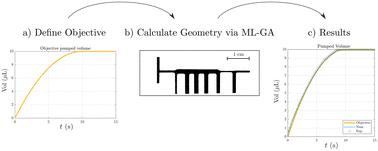Our official English website, www.x-mol.net, welcomes your feedback! (Note: you will need to create a separate account there.)
A machine learning-based framework to design capillary-driven networks
Lab on a Chip ( IF 6.1 ) Pub Date : 2022-11-08 , DOI: 10.1039/d2lc00843b Pedro Manuel Garcia Eijo 1 , Thomas Duriez 1 , Juan Martín Cabaleiro 1 , Guillermo Artana 1
Lab on a Chip ( IF 6.1 ) Pub Date : 2022-11-08 , DOI: 10.1039/d2lc00843b Pedro Manuel Garcia Eijo 1 , Thomas Duriez 1 , Juan Martín Cabaleiro 1 , Guillermo Artana 1
Affiliation

|
We present a novel approach for the design of capillary-driven microfluidic networks using a machine learning genetic algorithm (ML-GA). This strategy relies on a user-friendly 1D numerical tool specifically developed to generate the necessary data to train the ML-GA. This 1D model was validated using analytical results issued from a Y-shaped capillary network and experimental data. For a given microfluidic network, we defined the objective of the ML-GA to obtain the set of geometric parameters that produces the closest matching results against two prescribed curves of delivered volume against time. We performed more than 20 generations of 10 000 simulations to train the ML-GA and achieved the optimal solution of the inverse design problem. The optimisation took less than 6 hours, and the results were successfully validated using experimental data. This work establishes the utility of the presented method for the fast and reliable design of complex capillary-driven devices, enabling users to optimise their designs via an easy-to-use 1D numerical tool and machine learning technique.
中文翻译:

基于机器学习的框架来设计毛细管驱动网络
我们提出了一种使用机器学习遗传算法 (ML-GA) 设计毛细管驱动微流体网络的新方法。该策略依赖于专门开发的用户友好的一维数值工具,用于生成训练 ML-GA 所需的数据。此一维模型使用Y发布的分析结果进行了验证形毛细管网络和实验数据。对于给定的微流体网络,我们定义了 ML-GA 的目标,以获得一组几何参数,这些参数可以根据两条规定的输送体积随时间变化的曲线产生最接近的匹配结果。我们进行了超过 20 代的 10 000 次模拟来训练 ML-GA,并获得了逆向设计问题的最优解。优化用时不到 6 小时,并使用实验数据成功验证了结果。这项工作确立了所提出方法的实用性,可用于快速可靠地设计复杂的毛细管驱动设备,使用户能够通过易于使用的一维数值工具和机器学习技术优化他们的设计。
更新日期:2022-11-08
中文翻译:

基于机器学习的框架来设计毛细管驱动网络
我们提出了一种使用机器学习遗传算法 (ML-GA) 设计毛细管驱动微流体网络的新方法。该策略依赖于专门开发的用户友好的一维数值工具,用于生成训练 ML-GA 所需的数据。此一维模型使用Y发布的分析结果进行了验证形毛细管网络和实验数据。对于给定的微流体网络,我们定义了 ML-GA 的目标,以获得一组几何参数,这些参数可以根据两条规定的输送体积随时间变化的曲线产生最接近的匹配结果。我们进行了超过 20 代的 10 000 次模拟来训练 ML-GA,并获得了逆向设计问题的最优解。优化用时不到 6 小时,并使用实验数据成功验证了结果。这项工作确立了所提出方法的实用性,可用于快速可靠地设计复杂的毛细管驱动设备,使用户能够通过易于使用的一维数值工具和机器学习技术优化他们的设计。



























 京公网安备 11010802027423号
京公网安备 11010802027423号